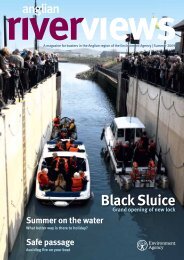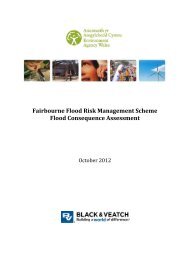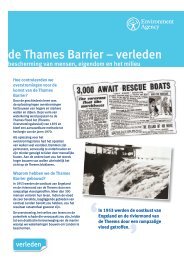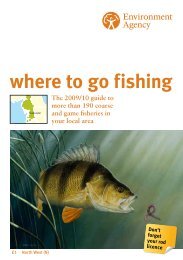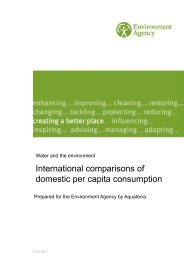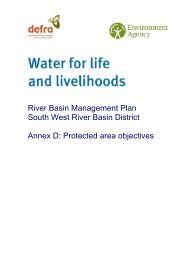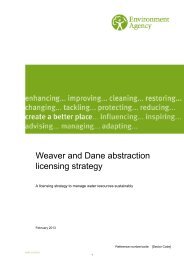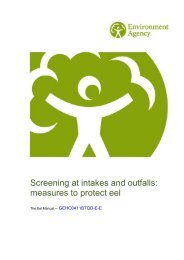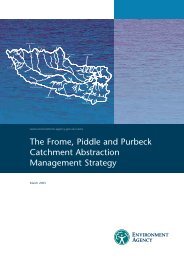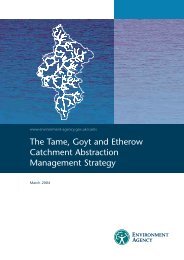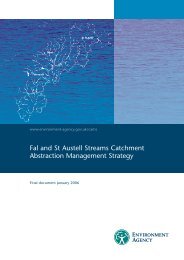Karenia mikimotoi
Karenia mikimotoi
Karenia mikimotoi
You also want an ePaper? Increase the reach of your titles
YUMPU automatically turns print PDFs into web optimized ePapers that Google loves.
The toxin(s) of K. brevisulcata have not yet been fully characterized but crude extracts<br />
have been shown to interact with mammalian sodium channels (Truman, 2007). The<br />
brevetoxins from the related K. brevis act on voltage-gated sodium channels and the K.<br />
brevisulcata toxins may prove to be brevetoxins or similar molecules.<br />
5.2.1 Ostreopsis ovata<br />
This dinoflagellate is known to produce palytoxin and its congeners, the ostreocins.<br />
Palytoxin, a large and complex molecule, is one of the most potent non-peptide toxins<br />
known, its mode of action being to inactivate Na + /K + ATPases. It has been implicated<br />
in seafood poisoning in tropical and sub-tropical areas (Katikou, 2007; Vale et al.,<br />
2007).<br />
In the summer of 2005, about 200 people who spent time on or near beaches in a<br />
stretch of the northwest Italian coast in the area of the city of Genova, sought medical<br />
treatment for symptoms such as rhinorrhoea, cough, fever, broncho-constriction with<br />
mild breathing difficulties, wheezing, and, in a few cases, conjunctivitis. For almost all<br />
these people, the symptoms stopped after a few hours, although 20 people required<br />
admission to hospital.<br />
The cause of these symptoms was suspected to be Ostreopsis spp. as in previous<br />
years, similar events were reported in other regions of Italy: Toscana (W coast of Italy),<br />
Puglia (SE coast of Italy) and Sicily, although these were not as widespread and as<br />
severe.<br />
In the first days few days of the incident Ostreopsis ovata was found to be present in<br />
seawater at cell densities up to several thousands cells.L -1 and hundreds of thousands<br />
of cells.g -1 of macroalgae. The analysis of water, plankton and macrophytes indicated<br />
the presence of palytoxin or one of its isomers (Brescanini et al., 2006; Barone, 2007).<br />
In 2006 a monitoring program was initiated, aiming to prevent further harmful exposure<br />
to these algae. Bathing was forbidden in an area about 10 km in length along the coast<br />
east of Genova from 29 July to 4 August after O. ovata was found to be present in<br />
significant numbers. This was the only control measure that could be applied to protect<br />
human health. Despite this precaution about 20 people reported symptoms similar to<br />
those observed in 2005, but it was thought that only a few of these were caused by<br />
inhalation of aerosolised O. ovata fragments (Brescanini et al., 2006).<br />
Clinical epidemiological studies were reported by Gallitelli et al. (2005) and Durando et<br />
al. (2007).<br />
The report of the ICES-IOC Working Group on Harmful Algal Bloom Dynamics<br />
(WGHABD) for 2005 (see list of reports at the end of the reference section) noted this<br />
event in 2004 -<br />
Spain<br />
Catalonia and Balearic Islands<br />
High concentrations (up to 10 5 cells L -1 ) of the benthic dinoflagellate<br />
Ostreopsis siamensis were observed to be resuspended in the water<br />
column in touristy (sic) beaches in August. There were 40 reports of human<br />
respiratory irritation at the beach of Llavaneras.<br />
- and the WGHABD report for 2007 noted the occurrence of these events in 2006 -<br />
34 A Literature review of the potential health effects of marine microalgae and macroalgae



